T here's no denying that the global market is a highly competitive landscape. The arrival of the age of information has only made businesses even more competitive, now on an international scale. Increasing success and business growth often breed competitors, and the journey to the top is equivalent to running a gauntlet. Gathering market research and intelligence on your direct and indirect competitors then becomes not just an effective strategy, but a necessity. According to Forbes, learning from the failures and successes of your competitors is a built-in boost for your company, saving you time, resources and money. There are a number of ways companies stack themselves up against their competitors, and one such form of a competitive analysis is a competitive matrix. In this detailed guide, let us look at this efficient and simple form of competitor analysis, which will familiarize you with different matrix examples and report templates. Let's begin.
What Is A Competitive Matrix?
A competitive matrix is a type of competitive analysis tool, which helps you learn about your market segment and identify opportunities. This in turn differentiates your brand from competitors, aids in creating better products, and helps in developing stronger marketing strategies. A competitive matrix thus can be quite useful in establishing your company's competitive advantage.
There are different types of competitive matrices, but most of them are simple charts wherein you list the main features and benefits of your product or service. On the top row, you list your company and the names of your competitors and fill in the chart with the appropriate information for each company. However, they can also be complex graphs with x and y axes representing unique positioning within a market segment. Competitive matrices can be used for any form of competitive analysis, including SWOT analysis, features and benefits analysis, content marketing strategies, review tracking, and much more.
Steps for Competitive Matrix Analysis
It is often said that a competitive matrix is only as good as the information included in it. Therefore, to get accurate data and details to use in your charts, it is imperative that you first perform a comprehensive competitive analysis. You can use insights gleaned from a competitive intelligence solution such as Contify. Do not jump into creating a competitive matrix before you've done extensive research and have enough data to plot on your chart. When you're satisfied, you may begin in the following manner:
1. Your competitive analysis will let you identify your current/direct and indirect/potential competition. It's a good idea to create the matrix from two different perspectives, i.e. one from the customer's point of view, and one from the business point of view.
2. Then you'll have to determine certain categories or areas to compare yourself with your competition. Pricing, customer service, product quality, marketing, etc. are some of the most popular areas to compare.
3. Now, on to the actual creation of the matrix. Use the columns on the left to write the names of your five major competitors, from top to bottom. You could also use separate tabs for separate competitors. Across the first row, left to right, list the categories or strategic areas you wish to compare (see below image). Evaluate the strengths and weaknesses (SWOT analysis) of each competitor on these parameters. Arrange your closest competitors next to you. Fill in your own company's information last.
4. Certain strategic areas may contain multiple variables, and it is not only okay but advisable to create separate matrices for them. For example, marketing can have a number of categories in itself including content marketing, paid advertising, inbound marketing, social media marketing, etc.
5. Once you've created your matrix or matrices, it is time to determine the areas where your company is weaker than the competitors. These gaps are in fact opportunities for your company to improve its market position by working exactly where you're lagging behind your competitors. Distribute it to the relevant teams in your organization.
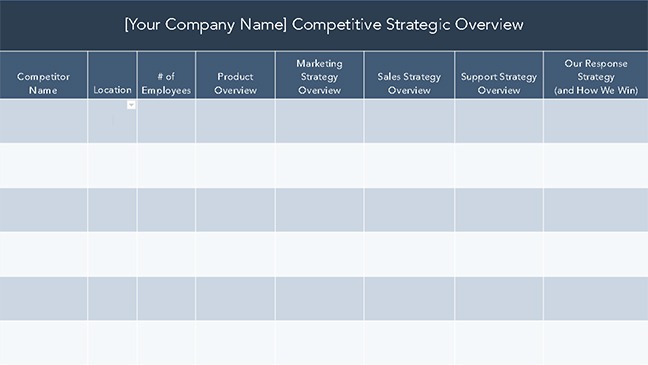
Five Competitive Matrix Analysis Templates/Examples
As mentioned before, there are multiple ways and templates of creating a competitive matrix. Let's have a look at some of the most common of them.
1. Feature Comparison Matrix
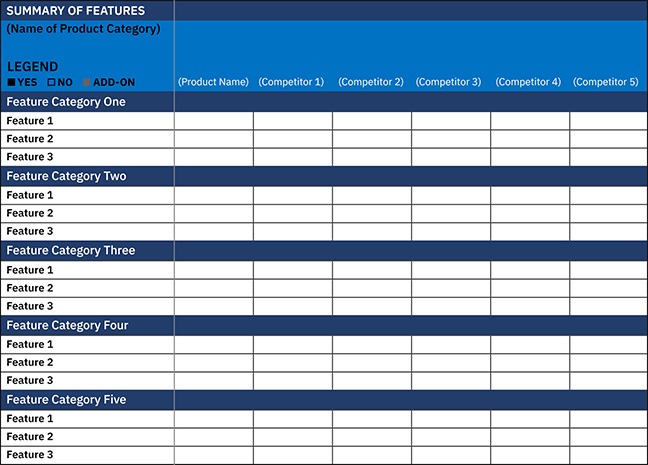
A feature comparison matrix allows you to compare your products and their features with those of your competitors. As you can see in the image, there are rows of features and columns of competitors to compare the product mix available from each competitor. This is quite a useful comparison as it allows you to understand the gaps in your product, as well as the features that make your product offering unique in the competitive landscape.
2. Competitive Analysis Matrix
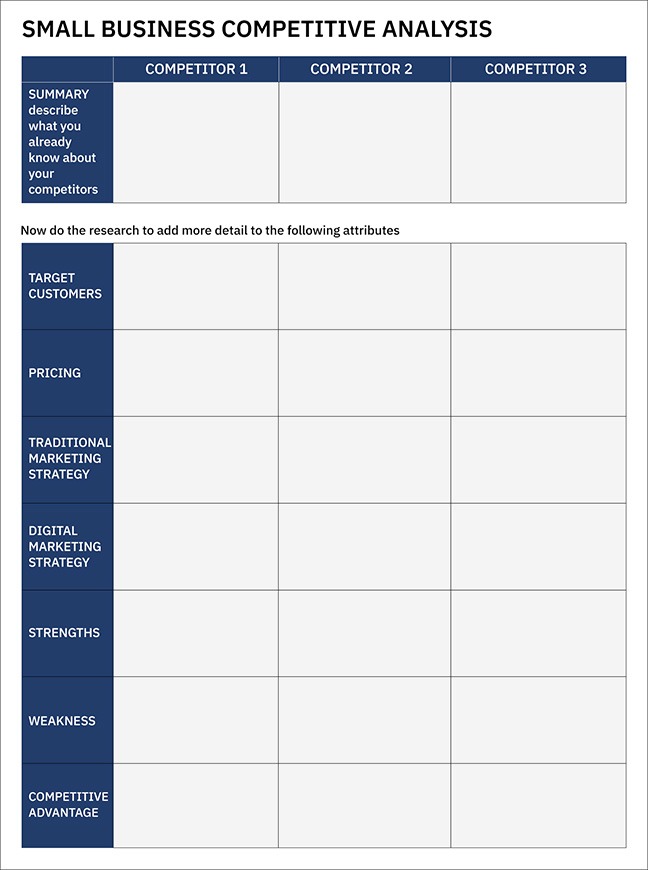
One of the most commonly used formats is a competitive analysis matrix. It gives you a bird's eye view of how you compare with your competitors in various categories such as target customers, pricing, marketing strategy (both online and general), strengths, weaknesses, competitive advantage, etc. This is a quite comprehensive comparison of you and your rivals and can help decide on changing an old strategy or creating a new business strategy.
Download competitive analysis template
3. Win/Loss Matrix
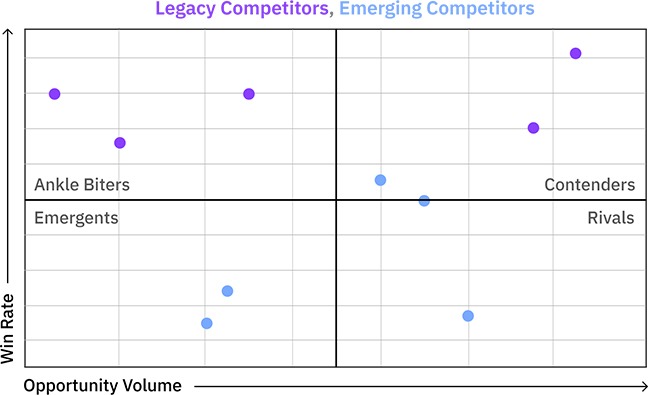
A win/loss matrix helps in identifying where your competitors stand as compared to your organization, in addition to their significance as a competitor. It can help you group your competitors as rivals, contenders, ankle-biters, and emergents, depending on the threat they pose to you. As its name suggests, this graph uses the win/loss rate of players in the competitive landscape to classify them. This will help you seek out ways to increase your overall competitive success.
4. Competitive Landscape Overview Matrix
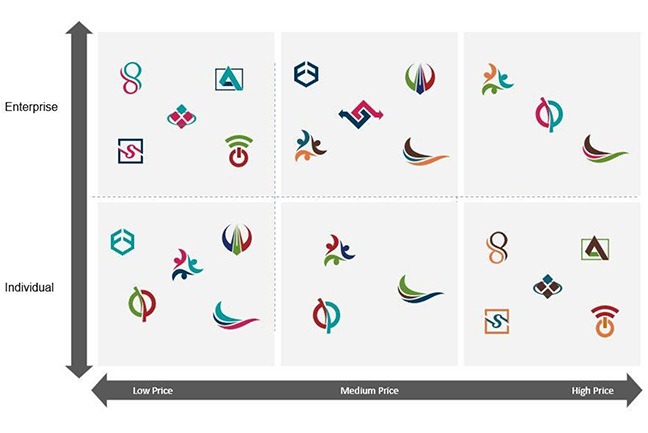
This is again a top-view of your entire competitive landscape. You can use your custom groupings, for example, legacy vs. emerging competitors, software vs. hardware competitors, direct vs. indirect competitors, and many more. A visual representation graph is easy to understand and can even be distributed to non-technical individuals in your organization to give them an idea/quick overview of your position in the marketplace.
5. Review Tracker Matrix
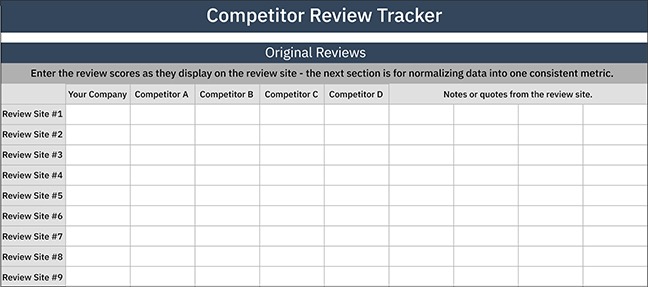
Reviews are critical for any company, whether product-based or service-based, as they help understand what your customers are saying about you. This can help plan changes in the product, as well as a marketing strategy. What's more important is understanding how your reviews compare with your rival's. Using a review tracker matrix, you can see - at a glance - the types of reviews you get versus your competitors.
Competitors Comparison With Competitive Matrix
We've already detailed the steps as to the creation of a competitive matrix, now let us look at its usage in competitor comparison.
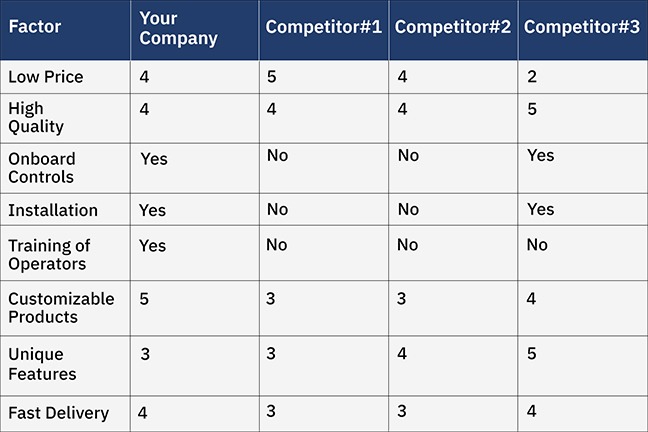
Let's say the image above is your competitive matrix. What competitive insights do we glean from it? When it comes to customization, your product comes out on top. In rapid delivery, you just have one competitor who's as quick as you. Your operators are skilled as you provide training, which other competitors don't. There's one competitor whose product has a superior quality as compared to yours, and another one who offers a lower price than yours. Two competitors are better than you in terms of unique features. Finally, there's one competitor that offers both onboard controls and installation, same as you. Based on this matrix, your company needs to take the following steps to outdo all your competitors:
1. Enhance the quality of your product.
2. Develop more unique features in your product. Form an internal team, set a timeline, and find available and affordable resources to help you get this done as quickly as possible.
3. Improve your delivery system to make it faster.
4. Find ways to minimize the final cost of your product.
Other steps that will be required as a part of your business strategy to outdo competitors will require a new marketing campaign to communicate the benefits of using your products more clearly to your competitors, making sure to cash in on the categories where you're stronger than your competitors. You can also use this competitive matrix as an internal sales training tool to help your sales team communicate your company’s competitive advantage more clearly to clients and/or customers.
The actual matrix you create will undoubtedly be longer and more detailed, but this example probably gives you an idea of how to use a competitive matrix for competitors’ comparison
Frequently Asked Questions (FAQs)
How To Create A Competitive Profile Matrix?
A competitive profile matrix is just another format of a competitive matrix. It helps you highlight the relative strengths and weaknesses as well as the value proposition of both your organization and your competitors. In addition, it helps uncover potential opportunities in the marketplace. Here's how it looks:
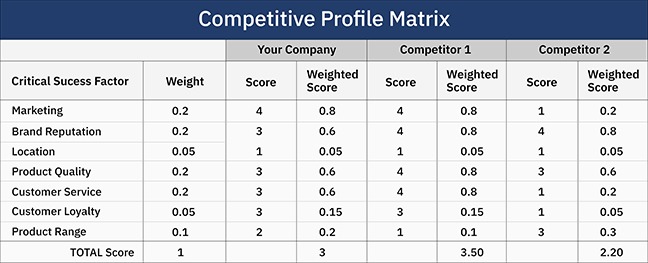
A competitive profile matrix has 4 components, namely:
- 1. Critical Success Factors
- These vary from company to company, but commonly include things like marketing, brand reputation, location, product quality, product range, customer service, customer loyalty, etc.
- 2. Weight
- Each critical success factor is assigned a weightage from 0.1 to 1.0, depending on their importance. A lower weightage means that the factor is not particularly important in determining the success of a business, and a higher weightage means that the factor is critically important.
- 3. Score
- The score assigned to each critical success factor signifies how strong that factor is. Multiplying the weight and score gives you a weighted score.
- 4. Total Score
- The sum of all the weighted scores of each critical success factor gives you the total score.
What Is The Purpose Of A Competitor Matrix?

When created and analyzed properly, a competitive matrix will give you plenty of quantitative and qualitative data to back your business decisions. Elevating your business, outdoing your competitors, and emerging at the top of your market is the final goal, and thus the purpose. However, reaching this final goal requires the fulfillment of smaller goals or milestones. A competitor matrix will help you realize these as well. These milestones include:
1. Developing or improving your Unique Value Proposition
2. Improving your product by comparing it with those aspects or features of competitors’ products that customers value
3. Capitalizing on competitors’ weaknesses
4. Getting benchmarks, against which you’ll measure your growth
5. Uncovering market segments that competitors haven't gotten to
6. Creating a new product category by identifying gaps between what your competitors offer and what the customers need
Conclusion
The key to being successful in any market segment is differentiation, and differentiation requires that you know yourself and your competitors inside out. That is the only way you can continually make your products and services more unique and distinctive, and deliver measurable benefits to your customers. A competitive matrix is a powerful tool to reveal all of this, and thus, a much-needed instrument in your journey to profitable and sustainable growth.










